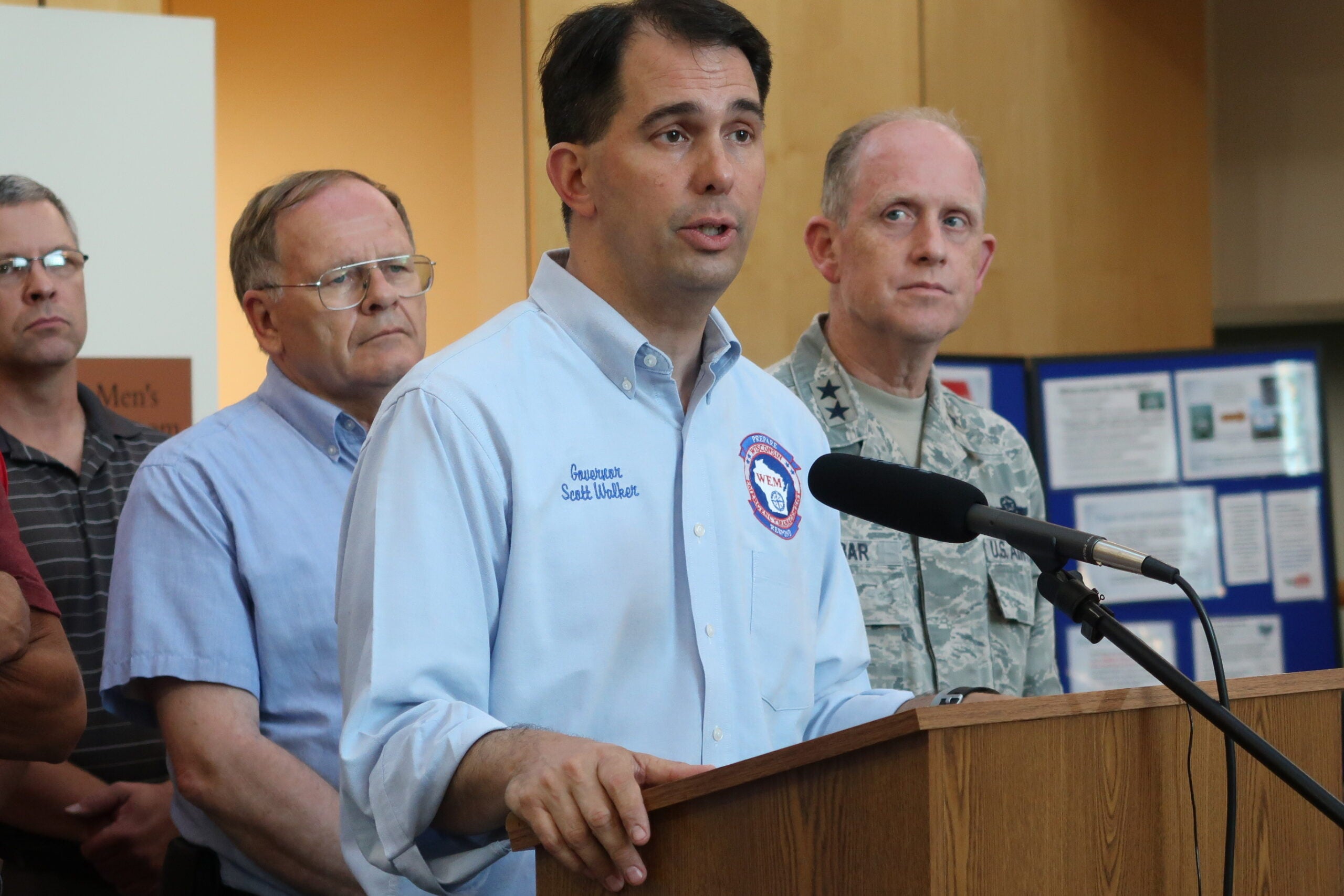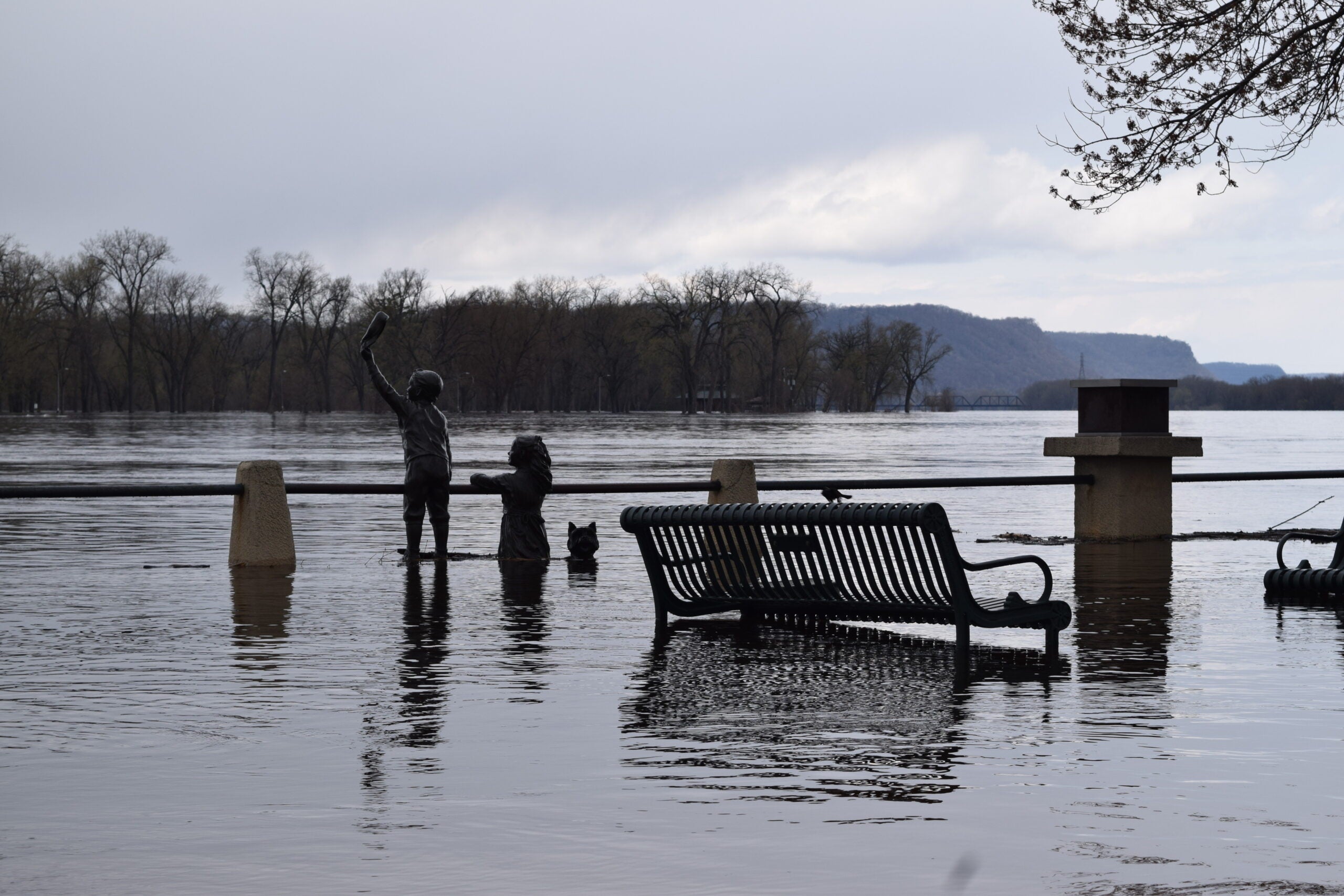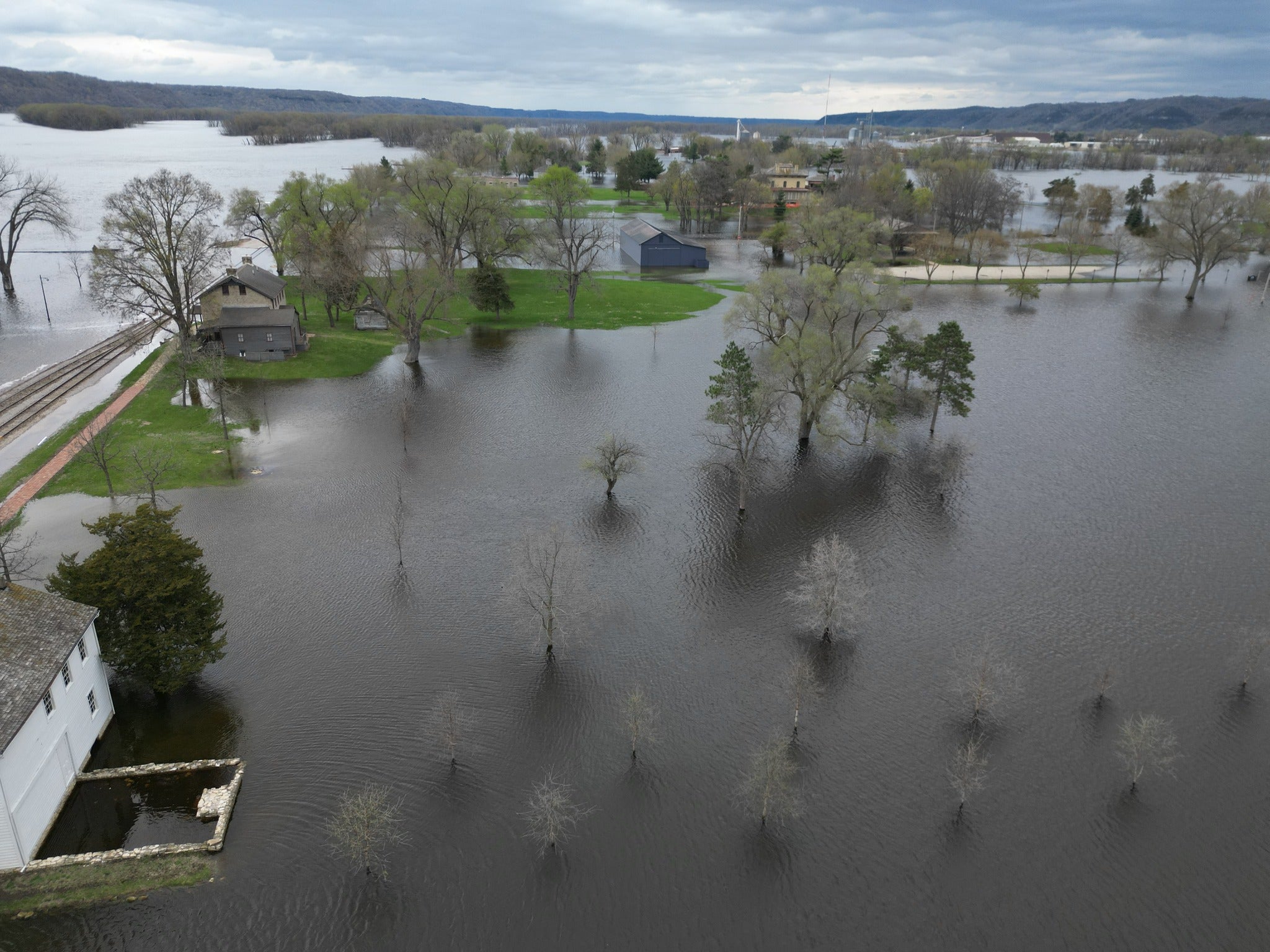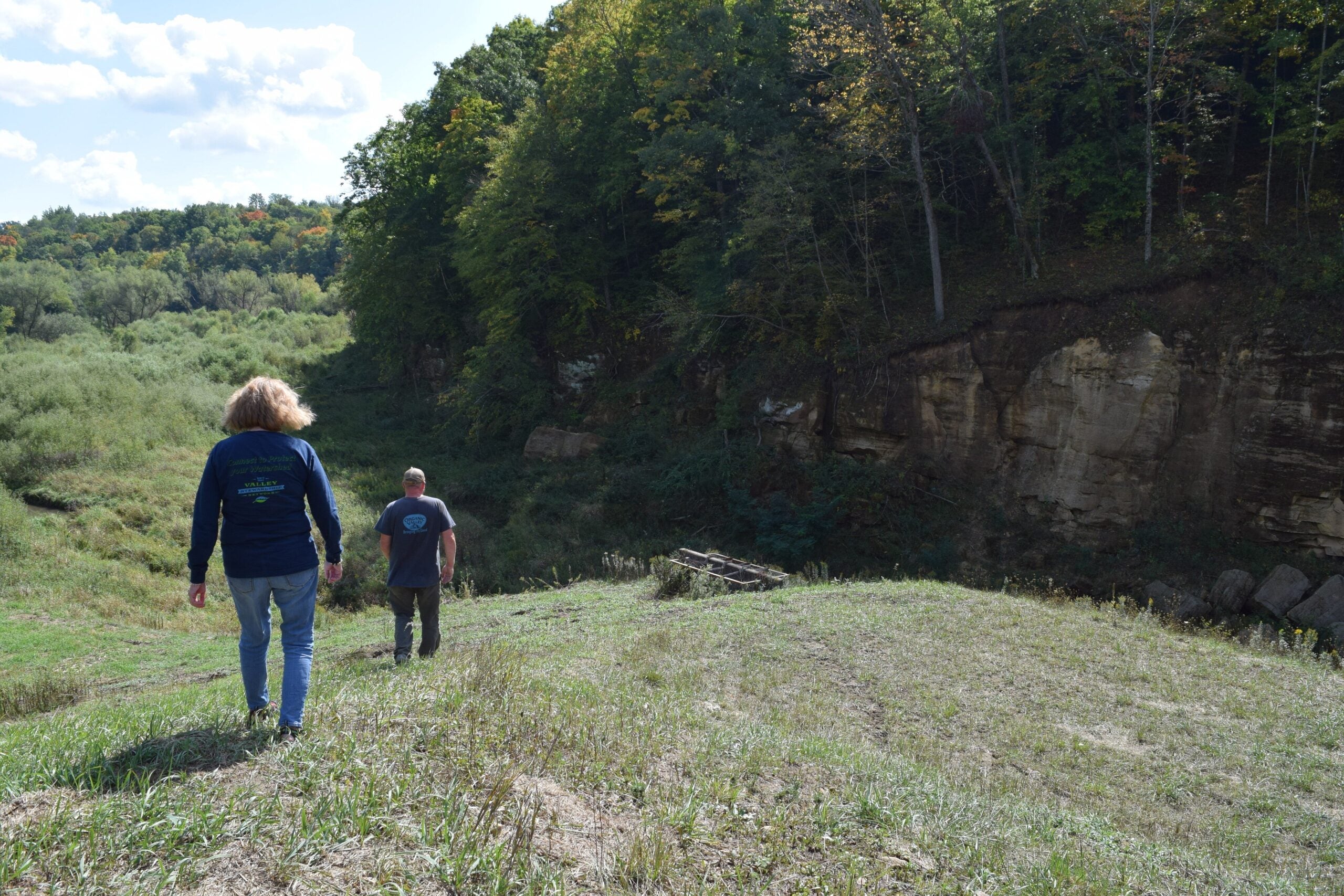Torrential rainfall and flash flooding took much of northwestern Wisconsin by storm, washing out roads, damaging buildings and leading to the death of at least two people.
While much of that rain has stopped, the aftermath of those storms — and the clean up that will be required — remains unknown. Many major highways remain closed and law enforcement in Douglas, Ashland, Bayfield, Pierce, Iron and Sawyer counties are encouraging travelers to stay off the roads and away from flooded areas.
Gov. Scott Walker declared a state of emergency in Ashland, Bayfield, Burnett, Douglas, and Iron counties Monday evening. Walker stopped in Superior after touring the damage across northern Wisconsin. He said state and local transportation officials are assessing what repairs are needed.
Stay informed on the latest news
Sign up for WPR’s email newsletter.
“If you don’t have access points, it makes it difficult first and foremost for just everyday residents to get around. It makes it difficult for commerce, and, of course, it makes it difficult this time of year for people to get to locations that are really important for tourism,” said Walker. “It’s paramount for us to make sure that major roadways are open.“
Walker said the state is just beginning to receive preliminary estimates from counties on the extent of the damage. He urged people to submit information to local emergency management officials about flood impacts so they can make the case for a federal disaster declaration.
“Our foremost interest in the last 24 hours has been safety — making sure that people are safe,” Walker said earlier Monday in Manitowoc before surveying the damage later in the day. “We didn’t go up earlier today because we wanted to be at a point where we weren’t interfering with emergency response teams and utility teams who were out assessing the damage and potentially helping people who might be stranded.”
Record-high water levels across northern Wisconsin increased the risk for flash flooding and caused the failure of the Radigan Flowage Dam, which sits on the Tamarack River 40 miles south of Superior.
The U.S. National Weather Service in Duluth, Minnesota posted a warning on Facebook, saying the dam’s failure caused the Tamarack River to flood. The post warns drivers to avoid flooded areas at all costs.
Joe Moore, a meteorologist at the National Weather Service in Duluth, said local officials say the dam is completely underwater but the increased flow downstream indicates a breach.
“We’re not sure if the structure is partially broken or completely broken or completely out, but we know that it is at least compromised to the point that there is water over it and there is flooding down stream of it,” Moore said.
Moore said the dam isn’t very large but was holding back a significant amount of water.
“This is an earthen dam. It’s approximately 10 feet high,” said Moore. “It’s not holding back a ton of water, at least as much as we can ascertain from local officials. It seems to be anywhere from a 60- to 150-acre flowage that’s behind it that varies between 10-15 feet in depth.”
Moore added that this is the only dam officials are worried about. Many are open in other areas of northwestern Wisconsin that he says can handle the heavy flow.
Impacts Across The Region
Andrew Beckett, a spokesman for Wisconsin Emergency Management, said a lot is unknown at this point.
Roads closed in Superior, Wisconsin due to flooding after heavy rainfall. Danielle Kaeding/WPR
“Right now, a lot of the counties are really working to get out there and find out what areas and what kind of damage was sustained and what kind of repairs might be needed,” Beckett said.
U.S. Highway 2, U.S. Highway 53 and State Highway 35 were some of the roads hardest hit by flooding, said Gary Brunner, project development section chief with the Wisconsin Department of Transportation. He said it may take four months to repair the washout at North Fish Creek on Highway 2 near Ino in Bayfield County.
“That will take a full replacement to recover on Highway 2. We are working on an alternative route on County G,” said Brunner. “The public is not going to have a long-term, long-distance detour.”
Brunner said staff hope to get a better damage assessment there Tuesday. He said they’ve been unable to assess the impacts to a bridge over the Black River on State Highway 35 until the water recedes.
Over the coming weeks, Moore said the NWS will continue to monitor rivers — including the St. Croix River — for additional flooding.
“The one that’s probably going to be long-term, at least for the next week, is going to be the St. Croix,” Moore said. “That river has been rising and probably will continue to rise because it has such a large area of tributaries that flow into it.”
Tim Boardwell and Jack Curly were eating breakfast Monday morning at the Manitou Inn in Douglas County.
Boardwell, who lives nearby, watched traffic as Wisconsin State Patrol troopers detoured vehicles away from the closed section of Wisconsin Highway 35.
“It’s not a problem except getting out of my house to come down the road there’s backed up — I think it’s two-and-a-half miles traffic backed up,” he said.
Boardwell said it didn’t look like traffic was going to get any better.
Over on U.S. Highway 2 in Superior, a section of the road was closed to traffic for a portion of Monday as the Nemadji River reached a record-high 30.3 feet and flowed over the highway.
Superior Mayor Jim Paine surveyed water running over U.S. Highway 2, which re-opened to traffic Monday afternoon.
“There’s a very large marshland, a bog, on either side of that highway that we built the highway through. That’s a continuous marsh. It’s meant to hold all that water,” he said. “It’s doing what it was supposed to do. It didn’t overwhelm the bridge — it didn’t reach the bridge.”
Bayfield County Sheriff Paul Susienka said some secondary roads are opening, but there are still several major closures. About half of the county’s roads are affected with either closures or sections of roads that have been closed due to washouts. He said they haven’t received many complaints so far from people about personal damage to property.
Michigan’s Upper Peninsula
In addition to much of northwestern Wisconsin, heavy thunderstorms also hit the western part of Michigan’s Upper Peninsula hard — where the National Weather Service reported more than 5 inches of rain fell on the area over the weekend.
Dan Weingarten, communications representative for the Michigan Department of Transportation-Superior Region, said the flooding is unlike anything he’s seen before.
“Nobody has seen anything like this. It’s absolutely unprecedented. I’ve heard speculation that it’s a 1,000-year flood,” Weingarten said. “The amount of water that came down in a short period of time just wreaked havoc. It’s definitely not anything that we were prepared for, or that anybody could be prepared for.”
Streets have been washed out in the city of Houghton, and homes and businesses there have been flooded.
“There may be up to 60 major washouts or sinkholes in the area,” Weingarten said. “Downtown Houghton has sustained a lot of damage in the business district. People are kind of in shock at how many things have been washed away or damaged.”
Portions of Michigan Highway 203 and Michigan Highway 26 are closed because of washouts. U.S. Highway 41 is down to one lane between Chassell and Houghton. Many smaller roads were also washed out and remain impassable. Weingarten said motorists should pay attention to the road closure signs and drive with caution.
Michigan’s governor issued disaster declarations for two counties in the state’s Upper Peninsula that suffered flooding damage after the heavy rains, according to The Associated Press.
Gov. Rick Snyder’s office said the Monday orders will allow the National Guard to deploy to the area, The Associated Press reported.
The National Weather Service in Duluth is predicting dry weather across the region for the rest of the week.
Editor’s note: This story was last updated at 9:04 a.m., Tuesday, June 19, 2018. Molly Dove, Danielle Kaeding, Rich Kremer, Glen Moberg, Patty Murray and Jenny Peek contributed to this story.
Wisconsin Public Radio, © Copyright 2024, Board of Regents of the University of Wisconsin System and Wisconsin Educational Communications Board.






